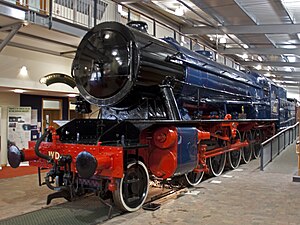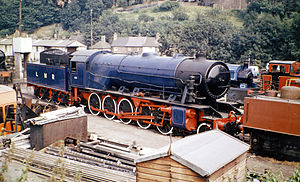LMR 600 Gordon
Contents
LMR 600 Gordon in service
Longmoor Military Railway No. 600 'Gordon' was built in 1943 at the North British Locomotive Company’s Hyde Park Works in Glasgow as works number 25437. The locomotive, which is named after General Gordon of Khartoum, is a World War 2 ‘Austerity’ locomotive designed by R. A. Riddles, and was the second of 150 such locomotives built. It was originally numbered WD 73651 for the War Department.
The standard War Department 2-8-0 freight locomotive was a simplified version of the LMS 8F. The 2-10-0 design was introduced to give a reduced axle loading, mainly intended for overseas use where track quality could be worse than the UK. To enable the locomotive to negotiate sharp curves, the 2-10-0’s centre driving wheels are flangeless whilst the next pairs have reduced flanges (a feature continued in the BR Standard 9F).
Although the 2-10-0 design was intended for overseas use, ‘Gordon’ only saw wartime service in the UK. Post-War, Gordon was mainly confined to the Longmoor Military Railway where, numbered 600, it was used by the Royal Engineers as a driver-training engine. However in 1957 during the Suez crisis, it is known to have worked highly secretive trains between Longmoor and Southampton.
Gordon’s last major steam event was the final open day at Longmoor camp on 5 July 1969. A photo may be found on Ernie's Railway Archive.
LMR 600 Gordon in preservation
Gordon was still the property of the British Army when the Longmoor Military Railway closed and was subsequently sold for non-military purposes. Following this closure, Gordon arrived on the SVR in September 1971 on loan from The Transport Trust, accompanied by three vintage carriages.
Gordon saw regular use in the early days of the SVR. In August 1975 it travelled to Shildon under its own power to attend the Rail 150 celebrations, and in 1980 it travelled in light steam to Bold Colliery from where it participated in the locomotive parade at Rocket 150 at Rainhill.
Gordon is one of only two steam locomotives on the SVR (along with 34027 Taw Valley) which are equipped to work with air-braked rolling stock. This facility was occasionally used in preservation, including in May 1982 when Gordon worked an incoming train of 19 wagons delivering 1,800 concrete sleepers[1].
Gordon last saw service on the SVR in 1999. It remained Army property until July 2008 when, by then the last steam locomotive owned by the Army, it was donated to the SVR. Gordon is now owned by SVR(H) and as of 2016[update] is on display in The Engine House at Highley.
See also
References
Information principally from a display poster in the Engine House and past copies of SVR News.
- ↑ SVR News 64




